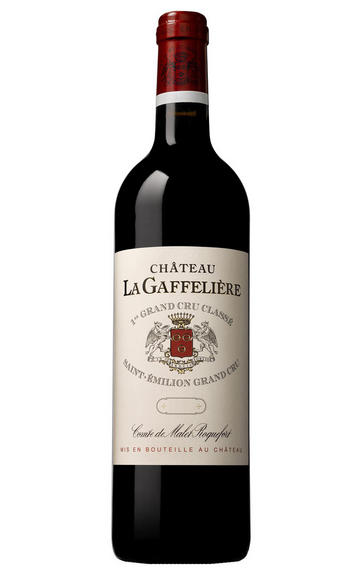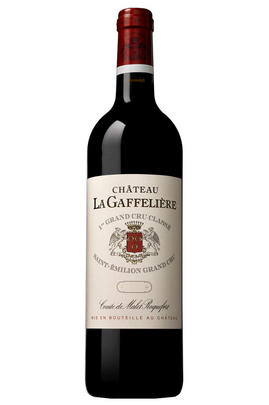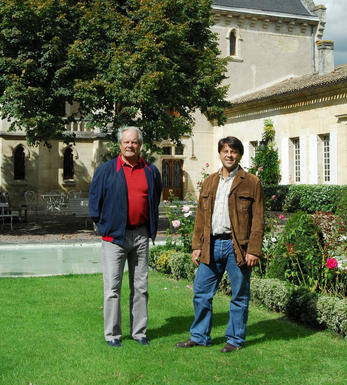
2021 Château La Gaffelière, St Emilion, Bordeaux

Critics reviews
The 2021 La Gaffelière has quite a powerful bouquet with ample black cherry and raspberry fruit, violet and licorice—aromatics you would misconstrue as those from a warmer growing season. The palate is medium-bodied and fleshy with ripe tannins and good depth. It has more fruit intensity than its peers, yet it manages to retain mineralité and composure toward the finish. This is an excellent Saint-Émilion from the top drawer.
Drink 2028 - 2055
Neal Martin, Vinous.com (February 2024)
The 2021 La Gaffelière is a wine of sublime elegance and understated finesse. Aromatic and pliant, the 2021 shows the more delicate side of the year, yet all the Gaffelière signatures are present. Lavender, mocha, spice, dried herbs and leather are some of the many notes that grace this exquisite Saint-Émilion. The balance here is mind-blowing. Give this time, as it won't be ready to drink anytime soon.
Drink 2031 - 2061
Antonio Galloni, Vinous.com (February 2024)
Showing well in bottle, with creamy raspberry, a lightness of touch coupled with good concentration and balance. Plenty of appellation limestone signature, this is good quality, one to look out for, delicate but with character and lift. Not tasted En Primeur, and enjoyable to get to know now. This is also a vintage with a footnote in history for Gaffelière, as it will be the last one bottled as a Premier Grand Cru Classé, after stepping down from the system in 2022.
Drink 2026 - 2041
Jane Anson, JaneAnson.com (December 2023)
58% Merlot, 42% Cabernet Franc.
Mid-deep ruby. Slick red fruit, a touch of bramble and savoury spice on the nose. Plump on the palate, glossy in fruit yet balanced by notes of rosemary and thyme. The tannins are on the firm side, coating the fruit in a sandy texture. Yet the stuffing seems to match the fruit. Earthy. Should get there.
Drink 2025 - 2039
Tom Parker MW, JancisRobinson.com (November 2023)
The 2021 La Gaffelière is quite rich and generous by the standards of the vintage, wafting from the glass with aromas of cherries and raspberries mingled with licorice, pencil shavings and creamy new oak. Medium to full-bodied, velvety and seamless, it has good depth at the core, lively acids and a sapid finish.
Drink 2025 - 2040
William Kelley, Wine Advocate (February 2024)
Lovely reduction at first that gives an ashy feel to the red berries, crushed stones, subtle cream, hibiscus and some dark-colored fruit. The medium- to full-bodied palate unleashes plenty of fine-grained tannins. Fresh, bright and more vertically structured than many of its peers from this vintage, but it remains polished and textured. Lingering finish.
Drink from 2024
James Suckling, JamesSuckling.com (January 2024)
One of the more complete 2021 wines in terms of energy and harmony. Fragrant and ripe fruit on the nose, perfumed black cherries and a dusting of milk chocolate, toasty wood and dark spices. This has a lovely presence on the palate, pure but with concentration and coolness at the same time. Stylish with energy and focus, lots of movement and forward motion. A great showing already.
Drink 2026 - 2046
Georgina Hindle, Decanter.com (November 2023)
One of the gems out there, the 2021 Château Canon-La-Gaffelière is well worth seeking out. Giving up ample blue fruits, medium to full-bodied richness, ripe tannins, and complex, pure aromatics of violets, iron, and tobacco, it shines for its balance and elegance while bringing a terrific depth of fruit. Count me impressed.
Jeb Dunnuck, JebDunnuck.com (May 2022)
About this WINE

Chateau La Gaffeliere
Château La Gaffelière is owned by Léo de Malet Roquefort, and the 22 hectare property produces on average 10,000 cases per year. Located in the centre of the St. Emilion appellation, due south of St. Emilion town, the property shares a similar climate to that enjoyed by both St.Emilion and Pomerol: more continental than the maritime Médoc, with generally more spring rainfall, though less in summer and winter.
La Gaffeliere's vineyards (Cabernet Sauvignon 5%, Merlot 65%, Cabernet Franc 30%) lie on a sloped sandy/clay-limestone topsoil and limestone subsoil (a mix of Côtes and Pieds de Côtes). Fermentation takes place in stainless steel followed by extended wood maturation, with 33% of the barells being renewed annually.
La Gaffeliere is classified as a 1er grand cru classé(B).

St Émilion
St Émilion is one of Bordeaux's largest producing appellations, producing more wine than Listrac, Moulis, St Estèphe, Pauillac, St Julien and Margaux put together. St Emilion has been producing wine for longer than the Médoc but its lack of accessibility to Bordeaux's port and market-restricted exports to mainland Europe meant the region initially did not enjoy the commercial success that funded the great châteaux of the Left Bank.
St Émilion itself is the prettiest of Bordeaux's wine towns, perched on top of the steep limestone slopes upon which many of the region's finest vineyards are situated. However, more than half of the appellation's vineyards lie on the plain between the town and the Dordogne River on sandy, alluvial soils with a sprinkling of gravel.
Further diversity is added by a small, complex gravel bed to the north-east of the region on the border with Pomerol. Atypically for St Émilion, this allows Cabernet Franc and, to a lesser extent, Cabernet Sauvignon to prosper and defines the personality of the great wines such as Ch. Cheval Blanc.
In the early 1990s there was an explosion of experimentation and evolution, leading to the rise of the garagistes, producers of deeply-concentrated wines made in very small quantities and offered at high prices. The appellation is also surrounded by four satellite appellations, Montagne, Lussac, Puisseguin and St. Georges, which enjoy a family similarity but not the complexity of the best wines.
St Émilion was first officially classified in 1954, and is the most meritocratic classification system in Bordeaux, as it is regularly amended. The most recent revision of the classification was in 2012

Merlot/Cabernet Franc
Merlot and Cabernet Franc are grape varieties commonly used in Bordeaux-style blends, particularly in the Bordeaux region of France. When these two grapes are blended, they can create a wine that combines the best characteristics of each variety.
Merlot is known for its smoothness, soft tannins, and ripe fruit flavours. It often contributes black cherry, plum, and chocolate flavours to the blend. The grapes are relatively easy to grow and ripen earlier than other Bordeaux varieties, making them versatile for blending.
Cabernet Franc, on the other hand, adds structure, depth, and complexity to the blend. It typically brings aromas of red fruits such as raspberry and strawberry, along with herbal notes like bell pepper and tobacco. These grapes have thinner skins and can be more challenging to cultivate, requiring specific growing conditions to reach their full potential.
When Merlot and Cabernet Franc are combined, the result is a well-balanced wine with various flavours and aromas. The blend often exhibits a Bordeaux wine's medium to full body, along with a smooth texture and moderate tannins. The specific flavour profile can vary depending on the proportions of each grape in the blend and the terroir and winemaking techniques employed.


Buying options
Add to wishlist
Description
Merlot 58%, Cabernet Franc 42%.
This is another beautiful wine from Alexandre de Malet Roquefort. He lost some fruit to frost and described the growing season as chaotic, but none of that is evident in this calm and serene wine. Imbued with the cool delicacy that comes from Cabernet Franc on limestone, this has a sense of reserve but without hauteur. The fruit accents are towards red berry but what beguiles about this wine is how its intensity gently amplifies on the palate, culminating in surprisingly long and insistent finish. This is fine and sophisticated.
Drink 2027 - 2045
Our score: 18/20
Berry Bros. & Rudd
wine at a glance
Delivery and quality guarantee